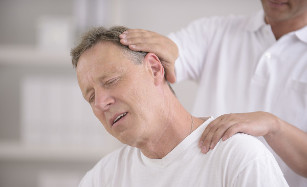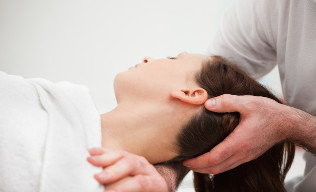
The cervical spine is the narrowest part of it, however, the daily load of the head support, ensuring its rotation and mobility of the shoulder joints is incomparably higher than the performance of other partshers.Given the wrong lifestyle caused by eating habits, sedentary work and smoking, the chances of developing cervical osteochondrosis in middle-aged people quadruple.
Despite such a prevalence of the disease, it is very difficult to identify osteochondrosis of the cervix in the early stages, as its symptoms are so different and, at first glance, are not related to the back problem, so much so that a person may not go to a doctor for years, given that the reason for his poor health is a completely different diseaseCauses of the disease
To ensure the movement of the vertebrae, there are intervertebral discs between them, consisting of cartilaginous tissue. They provide cushioning during movement and give flexibility to the back. The service life of intervertebral discs, determined by nature, is more than 120 years, but changes in the chemical composition of blood lead to rapid dehydration of cartilage tissue, the deposition of salts, which, in turn, contributes to the wearrapid of the discs and leads to their degenerative-dystrophic changes.
The reason for the change in blood composition is improper food, a sedentary lifestyle in which the body's cells do not need such an amount of salt and is deposited in bone tissue, liver and kidneys.In a forced sedentary lifestyle, the greatest amount of salt is deposited in the neck.
Cervical osteochondrosis can also occur as a result of microtrauma caused by vibration, for example, in drivers, as well as in the wrong forced position of the head or neck caused by working conditions and the specifics ofprofession.What is the risk of cervical osteochondrosis
In the cervical region, respectively near the cervical spine, there are nerve roots as well as vertebral arteries, whose task is to supply oxygen to the brain. With dehydration of the cervical intervertebral discs, their deformation occurs, and this narrows the gap between the vertebrae and leads to their damage during movement.Furthermore, salt deposition contributes to the formation of bone spines - osteophytes, which can damage nerve roots as well as the artery.
Ongoing, the disease leads to a violation of the sensitivity of the neck, shoulder, limbs, neck, or, conversely, causes pain in these parts, depending on the nerve roots that are tightened.
Compression of the vertebral artery is fraught with insufficient supply of oxygen to the brain, which leads to the development of various disorders of its activity. Among the most dangerous consequences of brain hypoxia are hearing disorders, decreased vision, stroke, partial and complete paralysis, mental disorders.
Osteochondrosis of the cervix is the most dangerous form of the disease, as it has many irreversible consequences, while people in the later stages of the disease usually seek help.Symptoms
The back of the cervix consists of 6 segments, through which pass different nerve roots, their violation is expressed with different symptoms. Depending on which cervical vertebrae are susceptible to osteochondrosis, the disease can manifest itself in a variety of symptoms. So, radicular syndrome is characterized by the following symptoms:
- Violation of the sensitivity of the neck, shoulder, fingertips, mostly unilateral. Sharp pain in the neck, radiating to the back or back of the head.
- Burning pain in the chest, shoulder, and one of the fingers, depending on which nerve is affected.
- Pain in the heart regionis characterized by its duration and intensification during sudden movements.
Compression of an artery, as well as small vessels, can lead to cerebral disorders, the symptoms of which can be listed as follows:
- Damage to vision, the appearance of "flies" in front of the eyes, blurred images.
- In case of insufficient nutrition of the cerebellum, dizziness, nausea, disturbances of consciousness may occur, the earth disappears from under the feet.
- If the blood supply to the brain is disturbed, there is a threat of its hypoxia and the body's response is the increased pressure needed to increase blood flow.
- Lack of oxygen also leads to a strong unreasonable fear of causing mixed periods.
- Potential impairment of coordination and hearing.
- When the lymph circulation is impaired, intracranial pressure occurs, expressed in headache in the parietal and occipital parts, pressure on the eyeballs, tinnitus.

Such varied symptoms and different single manifestations of the disease often do not immediately suggest back problems, especially since in the early stages, pain and stiffness of movements may be absent. And only a good specialist, who performs differential diagnoses, excluding other diseases characterized by the same symptoms, can detect cervical osteochondrosis.
Treatment
Treatment of osteochondrosis is a very long process and involves different methods of traditional and traditional medicine. The main tasks set by the doctor when choosing a therapy are pain relief, restoration of vertebral mobility and metabolic processes, replenishment of cartilage tissue, as well as removal of swelling and inflammation in the soft tissues of the neck. The methods by which the above goals are achieved are various, including taking medication, rubbing with oils, physiotherapy and special gymnastics. Hirudotherapy, acupuncture and traditional medicine prescriptions are used as adjunctive treatment.
The main component in the treatment of cervical osteochondrosis is the patient's initiative and strict adherence to the doctor's prescriptions.
Let's take a closer look at how to treat cervical osteochondrosis, as well as the features of the techniques:
Medications
Distinguish between treating osteochondrosis of the cervical spine during exacerbation and remission. So, in case of acute pain, the doctor may prescribe:
- Analgesicsin the form of tablets, injections, whose task is to relieve the symptoms of acute pain.
- Non-steroidal anti-inflammatory drugsin the form of injections, facilitating the inflammatory process. However, the side effects that accompany the use of NSAIDs do not allow their use for a long period.
- Muscle relaxantsrelieve muscle spasms and release tight vessels, nerves and arteries.
- Novocaine Blockade.This method is used for an acute attack accompanied by neck stiffness and pain. Treatment is performed under the supervision of a physician.
During the remission period, the main treatment is to take chondroprotectors produced in the form of powders and capsules, suspensions and oils. Chondroprotectors based on glycosaminoglycans and chondroitin sulfate have a number of positive effects on the cartilaginous tissue of the spine, namely, restoring the pulposus of the intervertebral disc nucleus, eliminating the pain syndrome and stopping the development of the disease.
Osteochondrosis ointments for cervical spine are prescribed at the doctor's discretion and have various effects, including:
- pain reliever;
- restoring cartilage structure;
- anti-inflammatory;
- heating;
- complex.
In addition, cervical osteochondrosis is characterized by compression of nerve roots and arteries, which leads to a number of symptoms, to eliminate which, appropriate medications are prescribed.
Physiotherapy
In addition to the main treatment, physiotherapeutic procedures are described, the purpose of which is to eliminate pain, improve microcirculation in soft tissues and restore metabolic processes. Some procedures, for example, electrophoresis, are used in conjunction with medicinal oils while achieving the maximum effect of the medicine.
In addition to electrophoresis, shock wave therapy, laser treatment, ultraviolet radiation and magnetotherapy are also used.
A similar effect is achieved with manual massage or acupuncture. A prerequisite for such treatment are higher qualifications and medical education by specialists in these areas.
Osteochondrosis of the cervix in remission is curable with physiotherapy exercises. Properly selected exercises eliminate the symptoms of pain and contribute to the elimination of salt deposits.
Folk remedies
Among the methods of treating osteochondrosis of the cervical spine recognized by official medicine, there are many popular recipes based on the healing properties of plants that have anti-inflammatory, warming and restorative metabolic processes.
The most common active ingredients in various interpretations are horseradish, Adam's root, aloe, ginger, garlic, bounce, pine nuts, honey and lemon. They are used for the preparation of rubs, oils, tinctures, compresses, swallowing mixtures, as well as medicinal baths. Traditional methods perfectly relieve symptoms, and also restore neck movement.

























